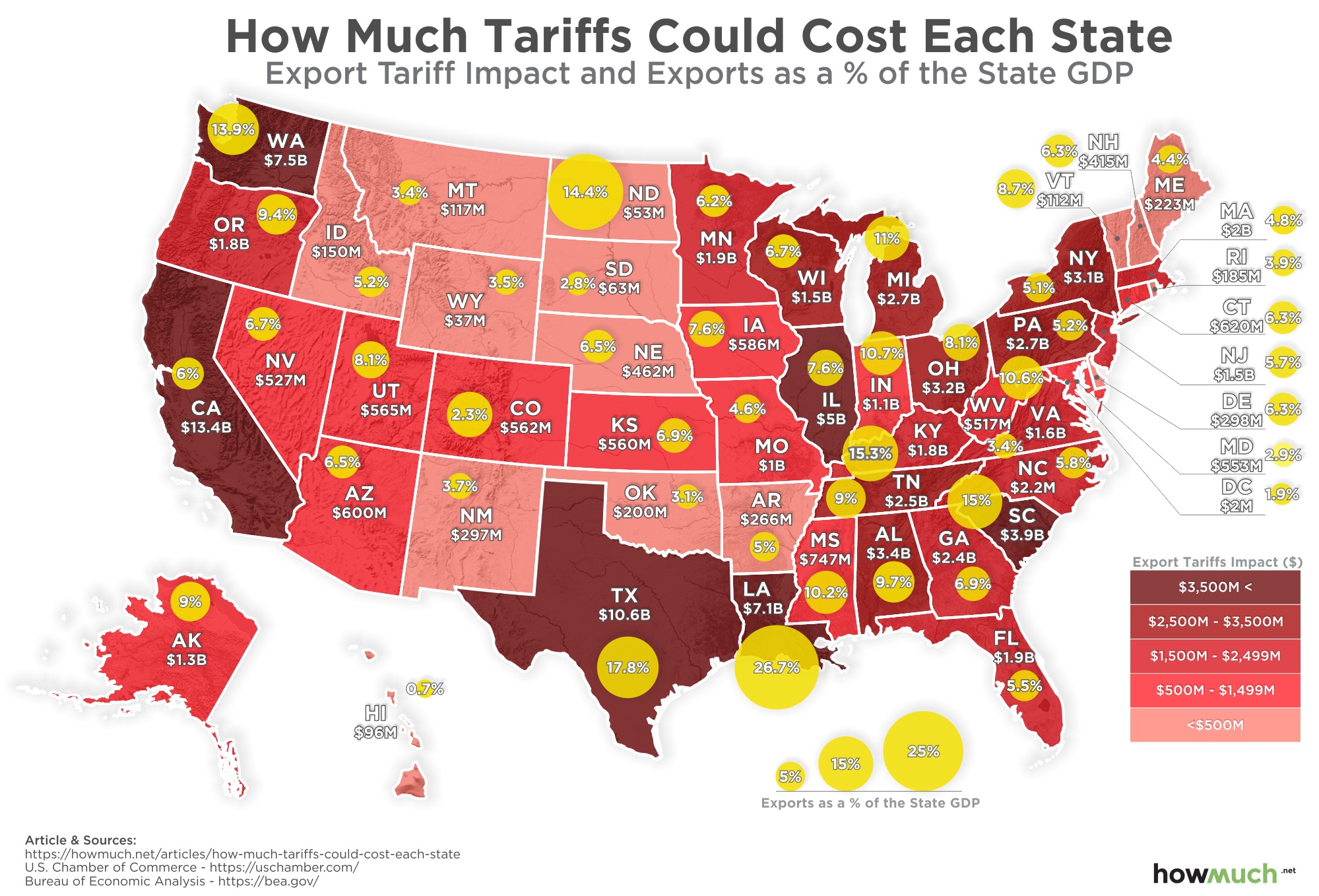Delayed Tariff Relief: The Impact On U.S. Allies Post-China Truce

Table of Contents
Economic Fallout for U.S. Allies: Assessing the Damage
The delayed implementation of tariff relief has inflicted considerable economic damage on U.S. allies. Increased costs, supply chain disruptions, and reduced competitiveness are just some of the consequences they continue to grapple with.
Increased Costs and Reduced Competitiveness
Delayed tariff relief translates directly into increased import costs for U.S. allies. This is particularly acute for countries heavily reliant on imports from China or other affected regions. These elevated costs erode profit margins, reduce competitiveness in global markets, and ultimately stifle economic growth.
- Manufacturing: Companies in the manufacturing sector, especially those relying on intermediate goods from China, face higher production costs, making them less price-competitive internationally.
- Agriculture: Farmers in countries exporting agricultural products to China have experienced reduced demand and lower prices due to retaliatory tariffs and weakened global trade.
Specific examples of economic hardship include:
- South Korea: The electronics and automotive industries have faced significant challenges due to increased input costs.
- Canada: The agricultural sector, notably the soy and canola industries, experienced substantial losses due to Chinese tariffs.
- Mexico: The automotive sector, heavily integrated with US supply chains, has faced disruptions and cost increases.
Supply Chain Disruptions and Uncertainty
Global supply chains are intricate webs of interconnected businesses. Tariffs disrupt these delicate networks, creating delays, bottlenecks, and increased uncertainty. Businesses heavily reliant on imports from China and other affected regions face significant challenges in maintaining consistent production and meeting consumer demand.
- Increased lead times: Shipping delays and customs procedures add to the cost and time required to procure goods.
- Diversion of trade flows: Businesses are forced to seek alternative suppliers, often at higher costs and with potential quality issues.
- Investment hesitancy: The unpredictability of tariff policies discourages businesses from making long-term investments.
Challenges faced by various sectors include:
- Technology: The semiconductor industry, heavily reliant on Chinese components, faces supply chain disruptions.
- Retail: Retailers struggle with higher costs and increased uncertainty in pricing and availability of imported goods.
- Pharmaceuticals: The pharmaceutical sector faces disruptions in the supply of active pharmaceutical ingredients.
Geopolitical Implications: Shifting Alliances and Trade Dynamics
The delayed tariff relief has not only had economic consequences but also significant geopolitical implications, straining relationships between the U.S. and its allies and fostering the rise of regional trade agreements.
Strained Relationships Between U.S. and Allies
The unpredictable nature of U.S. trade policy and the slow pace of tariff relief have eroded trust and cooperation between the U.S. and its allies. This has created resentment and potentially shifted alliances, fostering greater cooperation among other nations.
- Erosion of trust: Allies feel that their concerns have been overlooked, leading to frustration and decreased willingness to cooperate on other fronts.
- Increased bilateralism: Allies are more inclined to engage in bilateral trade agreements, bypassing multilateral institutions.
- Shifting trade partnerships: Some countries might seek closer trade relations with other powers like China.
Examples of diplomatic tension arising from tariff policies include:
- The ongoing disputes between the US and the EU regarding steel and aluminum tariffs.
- Trade tensions between the US and Canada over lumber and dairy products.
Rise of Regional Trade Agreements
The uncertainty surrounding U.S. trade policy has accelerated the development of regional trade agreements. Countries are seeking to solidify their trade relationships within specific regions, reducing reliance on potentially volatile global trade dynamics.
- Regional economic blocs: The formation of regional trade blocks strengthens economic integration within these regions.
- Reduced dependence on the US: Allies are diversifying their trade partnerships to lessen their dependence on the U.S. market.
- Challenges to multilateralism: The rise of regional agreements could undermine the effectiveness of global trade organizations.
Examples of new regional trade agreements include:
- The Comprehensive and Progressive Agreement for Trans-Pacific Partnership (CPTPP).
- The Regional Comprehensive Economic Partnership (RCEP).
Potential Solutions and Future Outlook: Navigating the Path Forward
Addressing the challenges posed by delayed tariff relief requires a multi-pronged approach involving both the U.S. and its allies. Negotiating comprehensive trade agreements and investing in domestic industries are key components of a viable solution.
Negotiating Comprehensive Trade Agreements
The U.S. needs to engage in constructive negotiations with its allies to address tariff-related issues. This requires transparent and predictable trade policies that promote fair competition and minimize disruptions.
- Clear communication: The U.S. needs to clearly communicate its trade policy goals and timelines to its allies.
- Predictable rules: Stable and transparent trade policies are essential for fostering long-term investment and growth.
- Mutual benefit: Trade agreements should be designed to benefit all participating countries.
Investing in Domestic Industries and Diversification
U.S. allies can mitigate the impact of delayed tariff relief by investing in domestic industries and diversifying their supply chains. This includes supporting innovation and technological advancement.
- Reshoring and nearshoring: Moving production closer to home reduces reliance on distant suppliers.
- Technological upgrades: Investing in automation and technology enhances efficiency and competitiveness.
- Skills development: Training the workforce for higher-skilled jobs is crucial for long-term economic growth.
Conclusion: Addressing the Challenge of Delayed Tariff Relief
The significant economic and geopolitical consequences of delayed tariff relief for U.S. allies cannot be overstated. The increased costs, supply chain disruptions, and strained relationships highlight the urgency of addressing this issue. Prompt action is needed to mitigate the negative effects and foster a more stable and equitable trading environment. Understanding the lasting implications of delayed tariff relief is crucial. Stay informed about ongoing developments and advocate for policies that ensure a stable and equitable trading environment for all. Let's work together to find lasting solutions for the challenges posed by tariff delays and foster stronger, more resilient global trade relationships.

Featured Posts
-
 The Trial Deciphering Teahs Involvement And The Familys Hidden Truths
May 19, 2025
The Trial Deciphering Teahs Involvement And The Familys Hidden Truths
May 19, 2025 -
 Comesana En El Atp 500 De Hamburgo Acceso Al Cuadro Y Proximos Partidos
May 19, 2025
Comesana En El Atp 500 De Hamburgo Acceso Al Cuadro Y Proximos Partidos
May 19, 2025 -
 Jennifer Lawrence Spotted On A Stroll With Husband Cooke Maroney
May 19, 2025
Jennifer Lawrence Spotted On A Stroll With Husband Cooke Maroney
May 19, 2025 -
 La Historia De Espana En Eurovision Triunfos Fracasos Y Momentos Clave
May 19, 2025
La Historia De Espana En Eurovision Triunfos Fracasos Y Momentos Clave
May 19, 2025 -
 Haalands Hat Trick Inspires Norways 5 0 World Cup Qualifying Win
May 19, 2025
Haalands Hat Trick Inspires Norways 5 0 World Cup Qualifying Win
May 19, 2025
